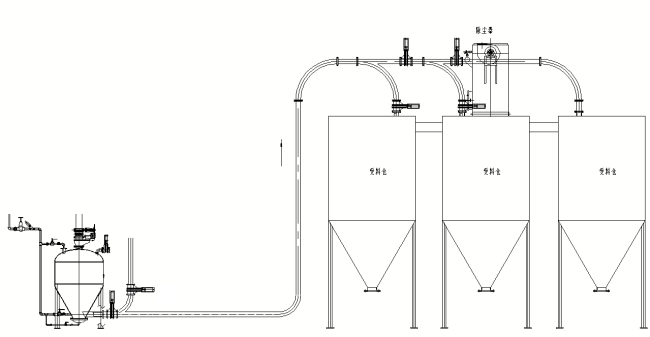News
A pneumatic conveying system is a method of transporting bulk materials (such as powders, granules, or pellets) through enclosed pipelines using a stream of air or other gas. It relies on the principles of airflow dynamics to move materials from one location to another, typically within industrial processes. Here's a detailed explanation:
Air Source: A blower, fan, or compressor generates the airflow required to propel materials.
Feeding Device: Introduces materials into the pipeline (e.g., rotary valves, screw feeders, or venturi systems).
Conveying Pipeline: Ducts or tubes through which materials are transported.
Separator/Filter: Separates materials from the air at the destination (e.g., cyclone separators, bag filters).
Control System: Regulates airflow, pressure, and material feed rates.
The system uses differential pressure or airflow velocity to suspend and transport materials. There are two primary modes:
Dilute Phase (Lean Phase) Conveying:
High airflow velocity (15–30 m/s) keeps materials fully suspended in the air.
Suitable for lightweight, non-abrasive materials over long distances.
Operates under positive pressure (pushing materials) or vacuum (suction).
Dense Phase Conveying:
Low airflow velocity (2–10 m/s) with materials moving in slugs or waves.
Ideal for fragile, abrasive, or heavy materials to minimize degradation.
Requires higher pressure and energy.
Industries: Food processing, pharmaceuticals, chemicals, cement, plastics, and agriculture.
Common Materials: Flour, sugar, cement, plastic pellets, coffee beans, and powdered chemicals.
Flexibility: Pipelines can be routed around obstacles.
Dust-Free: Enclosed system prevents contamination and dust emissions.
Automation: Easily integrated with process controls.
Efficiency: Rapid transport over horizontal, vertical, or complex paths.
Energy consumption (especially for long distances).
Material degradation if airflow is too aggressive.
Pipeline wear from abrasive materials.
In summary, a pneumatic conveying system is a versatile, clean, and efficient solution for moving dry bulk materials in industrial settings, tailored to material properties and operational requirements.

Welcome to click to inquire about product details and obtain a free pneumatic conveying solution!
Copyright © :Juheng Technology备案号:鲁ICP备15004282号-20 Website map(baidu / google)
technical support:Juheng Technology[Pneumatic conveying valve] 统计代码放置